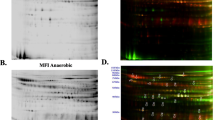Culturing of Mycoplasma hominis in the presence of arginine and thymidine and subsequent comparative proteomic analysis of cells showed that, in addition to the already known arginine dihydrolase pathway of energy metabolism, M. hominis can utilize deoxyribose phosphates formed as a result of catabolism of pyrimidine nucleosides. In this case, a sharp deceleration of cell growth was observed. This allows M. hominis to occupy new niches in the host organism and survive under competitive conditions when the main sources of energy are unavailable.
Similar content being viewed by others

References
Rakovskaya IV, Gorina LG, Balabanov DN, Levina GA, Barkhatova OI, Goncharova SA, Gamova NA. Generalized mycoplasma infection in patients and carriers. Zh. Mikrobiol., Epidemiol. Immunol. 2013;(2):37-43. Russian.
Desantis I, Tryon VV, Pollack JD. Metabolism of mollicutes: the Embden-Meyerhof-Parnas pathway and the hexose monophosphate shunt. J. Gen. Microbiol. 1989;135:683-691.
Ermolaeva SA, Rakovskaya IV, Miller GG, Sysolyatina EV, Mukhachev AY, Vasiliev MM, Adgamov RR, Levina GA, Petrov OF, Morfill GE, Grigoriev AI, Fortov VE, Gintsburg AL. Nonthermal plasma affects viability and morphology of Mycoplasma hominis and Acholeplasma laidlawii. J. Appl. Microbiol. 2014;116(5):1129-1136. https://doi.org/10.1111/jam.12445
Fisunov GY, Evsyutina DV, Semashko TA, Arzamasov AA, Manuvera VA, Govorun VM, Letarov AV. Binding site of MraZ transcription factorin Mollicutes. Biochimie. 2016;125:59-65. https://doi.org/10.1016/j.biochi.2016.02.016
Matyushkina D, Pobeguts O, Butenko I, Vanyushkina A, Anikanov N, Bukato O, Evsyutina D, Bogomazova A, Lagarkova M, Semashko T, Garanina I, Babenko V, Vakhitova M, Ladygina V, Fisunov G, Govorun V. Phase transition of the bacterium upon invasion of a host cell as a mechanism of adaptation: a Mycoplasma gallisepticum model. Sci. Rep. 2016;6:35959. https://doi.org/10.1038/srep35959
Pereyre S, Sirand-Pugnet P, Beven L, Charron A, Renaudin H, Barré A, Avenaud P, Jacob D, Couloux A, Barbe V, de Daruvar A, Blanchard A, Bébéar C. Life on arginine for Mycoplasma hominis: clues from its minimal genome and comparison with other human urogenital mycoplasmas. PLoS Genet. 2009;5(10):e1000677. https://doi.org/10.1371/journal.pgen.1000677
Rich JJ, Kinscherf TG, Kitten T, Willis DK. Genetic evidence that the gacA gene encodes the cognate response regulator for the lemA sensor in Pseudomonas syringae. J. Bacteriol. 1994;176(24):7468-7475. https://doi.org/10.1128/jb.176.24.7468-7475.1994
Rottem S. Interaction of mycoplasmas with host cells. Physiol. Rev. 2003;83(2):417-432. https://doi.org/10.1152/physrev.00030.2002
Shevchenko A, Wilm M, Vorm O, Mann M. Mass spectrometric sequencing of proteins silver-stained polyacrylamide gels. Anal. Chem. 1996;68(5):850-858. https://doi.org/10.1021/ac950914h
Waites K, Talkington D. New developments in human diseases due to mycoplasmas. Mycoplasmas. Molecular biology pathogenicity and strategies for control. Blanchard A, Browning G, eds. CRC Press, 2005. P. 289-354.
Wong SS, Yuen KY. Acute pyelonephritis caused by Mycoplasma hominis. Pathology. 1995;27(1):61-63. https://doi.org/10.1080/00313029500169482
Zgoda V, Tikhonova O, Viglinskaya A, Serebriakova M, Lisitsa A, Archakov A. Proteomic profiles of induced hepatotoxicity at the subcellular level. Proteomics. 2006;6(16):4662-4670. https://doi.org/10.1002/pmic.200600342
Author information
Authors and Affiliations
Corresponding author
Additional information
Translated from Byulleten’ Eksperimental’noi Biologii i Meditsiny, Vol. 171, No. 4, pp. 458-462, April, 2021
Rights and permissions
About this article
Cite this article
Pobeguts, O.V., Galyamina, M.A., Zubov, A.I. et al. Comparative Proteomic Analysis of Mycoplasma hominis Grown on Media with Different Carbon Sources. Bull Exp Biol Med 171, 449–452 (2021). https://doi.org/10.1007/s10517-021-05247-8
Received:
Published:
Issue Date:
DOI: https://doi.org/10.1007/s10517-021-05247-8



